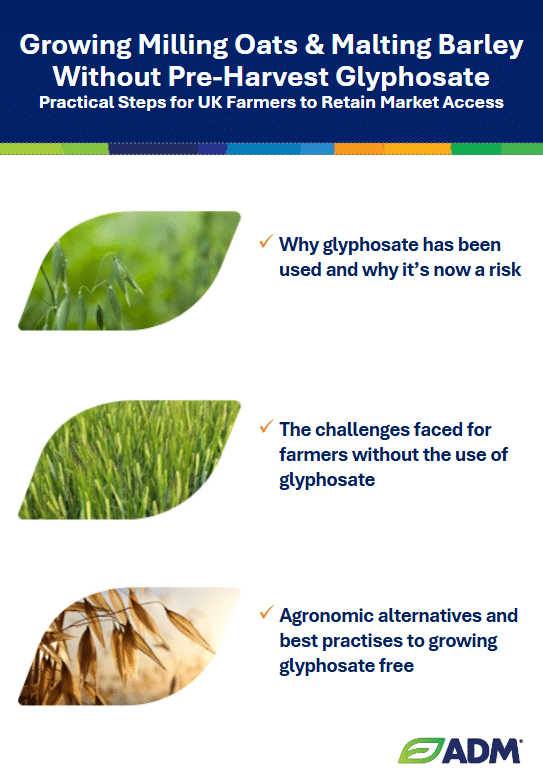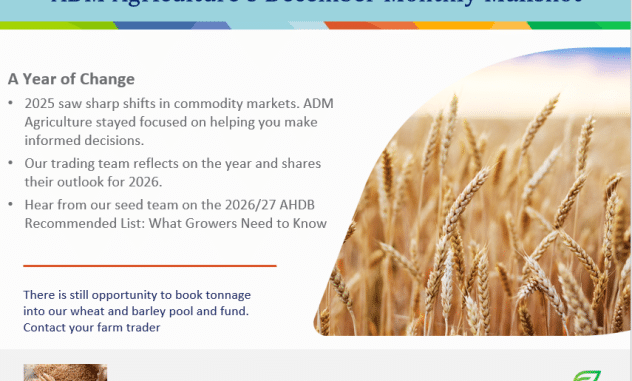For UK arable farmers, milling oats offer a valuable break crop with good market potential—both domestically and for export. But with growing scrutiny over glyphosate use, particularly as a pre-harvest treatment, growers need to reassess their approach to ensure long-term market access. This is especially relevant now that EU regulations recommend the ban of pre-harvest desiccation of oats for the human consumption market. The application of this recommendation is up to the individual EU member state as to whether they adopt it within their purchasing terms.
Many maltsters and oat buyers—especially those supplying the European and North American food markets—are now demanding oats and barley free from glyphosate residues. Even though glyphosate desiccation remains legal in the UK, it is likely that the UK will soon follow suit; relying on it risks excluding you from certain contracts and end markets.
We are already seeing some domestic maltsters tightening up their stance on this, but oat millers are currently okay. Therefore, in seasons when domestic demand is saturated or when premiums are weak, access to all markets is vital to ensure that growers get a fair price and can maximise their gross margins. Losing access to them is therefore not an option for many growers.
Why Glyphosate Has Been Used—and Why It’s Now a Risk
Glyphosate has been used pre-harvest to control green weeds and to even out crop dry-down, especially where field ripening is uneven. However, this practice is increasingly frowned upon by food-grade oat and barley buyers, and residue limits are tightening.
In some seasons, when the UK exceeds domestic demand, the export market—particularly to mainland Europe including Germany, Belgium, and Spain—acts as a crucial outlet. But many of these markets now operate with zero tolerance for glyphosate residues, meaning any crop treated before harvest may be rejected outright.
Challenges Without Glyphosate
Removing pre-harvest glyphosate isn’t without its complications:
- Weed contamination: Late-germinating broadleaved weeds can still be active in July and August. Without glyphosate, these weeds can increase admixture and reduce grain cleanliness, risking rejection.
- Uneven maturity: Especially in seasons with variable rainfall or on heavier land, patches of green crop can delay harvest and increase drying costs.
- Lodging risk: Delayed harvest due to uneven ripening increases the risk of the crop going flat, complicating combining and increasing losses.
Agronomic Alternatives and Best Practice
The key to growing glyphosate-free lies in forward planning and tight agronomic control:
- Variety Selection: Choose varieties with strong straw, even ripening habits, and early maturity. Modern varieties are increasingly bred with these traits in mind.
- Sowing Date: Earlier sowing from February into early March encourages stronger establishment and more even crop development, reducing maturity variation at harvest, and has also been shown to deliver the highest yield performance.
- Weed Control: Maximise early weed control using pre-emergence herbicides and spring mechanical weeding if appropriate. Manage weed seedbanks rotationally.
- Nutrition and PGRs: Well-timed nutritional programmes support crop health and standing power. PGRs can help reduce lodging risk.
- Monitoring and Harvest Timing: In seasons such as the current year, where high temperatures and dry conditions have moved harvest forward significantly, utilising natural crop senescence removes the requirement for pre-harvest glyphosate. In other seasons, monitoring the crop and timing harvest—prioritising these crops—will be key.
In years when domestic demand is oversupplied, being able to sell into Europe or other glyphosate‑sensitive export markets gives your crop added flexibility and financial resilience.
Summary
Growing milling oats and malting barley without pre-harvest glyphosate requires attention to detail, but it’s a shift many UK farmers are already making. By adapting your agronomy now, you can safeguard both crop quality and access to a wider range of markets in the years ahead.



